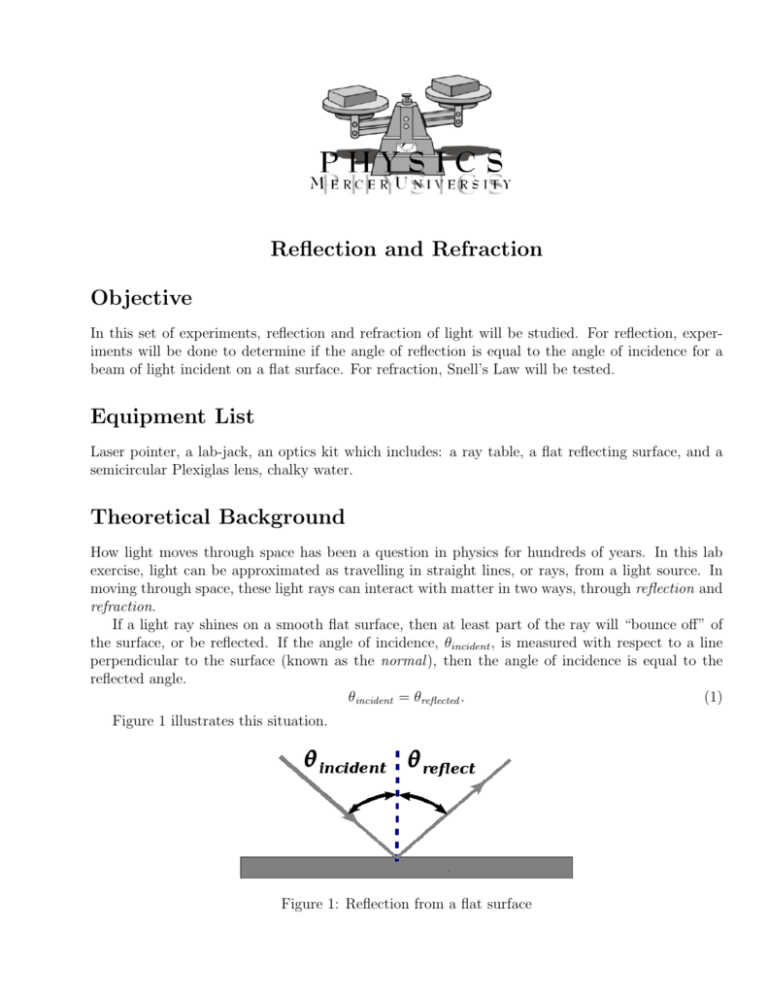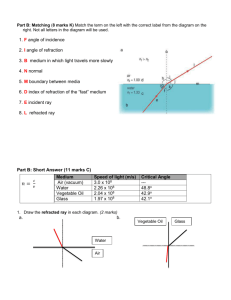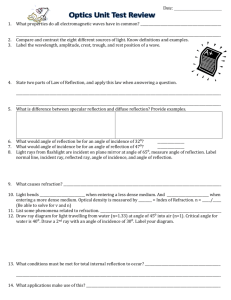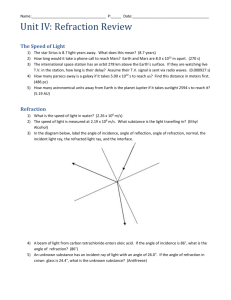Reflection and Refraction Objective Equipment List Theoretical
advertisement

Reflection and Refraction Objective In this set of experiments, reflection and refraction of light will be studied. For reflection, experiments will be done to determine if the angle of reflection is equal to the angle of incidence for a beam of light incident on a flat surface. For refraction, Snell’s Law will be tested. Equipment List Laser pointer, a lab-jack, an optics kit which includes: a ray table, a flat reflecting surface, and a semicircular Plexiglas lens, chalky water. Theoretical Background How light moves through space has been a question in physics for hundreds of years. In this lab exercise, light can be approximated as travelling in straight lines, or rays, from a light source. In moving through space, these light rays can interact with matter in two ways, through reflection and refraction. If a light ray shines on a smooth flat surface, then at least part of the ray will “bounce off” of the surface, or be reflected. If the angle of incidence, θincident , is measured with respect to a line perpendicular to the surface (known as the normal ), then the angle of incidence is equal to the reflected angle. θincident = θreflected . (1) Figure 1 illustrates this situation. Figure 1: Reflection from a flat surface 2 Reflection and Refraction If light shines on a transparent material, then part of the light ray will pass through the material. The part of the ray that passes into the material is “bent” or refracted. This bending, or change in the direction of the ray occurs only at the interface between the two materials. The interaction of the light with the transparent material changes the speed of light as it passes through the material. The relationship between the speed of light in a vacuum c and the speed of light in the material v is known as the index of refraction n. The index of refraction is defined in the following equation: c n= . v (2) This speed change causes the light ray to bend. Equation 2 can be used to find a relationship between the angle of the incident wave, still measured with respect to the normal, and the angle of the light ray as it moves through this second material, known as the angle of refraction. This new relationship is known as Snell’s Law, stated mathematically in the following equation: ni sinθi = nr sinθr . (3) In this equation, ni is the index of refraction of the medium the incident ray is moving through, θi is the incident angle, nr is the index of refraction of the medium the refracted ray is moving through, and θr is the angle of refraction. Figure 2 illustrates the relationship between the variables. Figure 2: Refraction through a material In Figure 2, it has been assumed that nr is larger than ni so that the refracted ray is deflected toward the normal. If the incident medium has the larger index of refraction, then the refracted ray will be deflected away from the normal. In this case, if the angle of incidence is large enough, the refracted ray will be bent through an angle equal to, or larger than, 90◦ so that the ray will remain inside the material. This is known as total internal reflection, and is the basis for fiber optics used in telecommunications. Using Snell’s law, the minimum, or critical, angle for total internal reflection can be found by setting the refracted angle, θr in Equation 3, to 90◦ so that the sin(90◦ ) is one. Substituting this into the Equation 3, we get the following: ni sin(θcritical ) = nr . (4) v:S08 Reflection and Refraction 3 In this equation, ni is the index of refraction of the incident medium, nr is the index of refraction of the refraction medium, and θcritical is the critical angle for total internal reflection. You will test these relationships in this set of experiments using a laser pointer as the source of the light ray. Procedure Safety Note: Be careful not to look directly into the laser beam!! You may damage your eye if you look directly in to the laser!! Do not shine the laser pointer at anyone!! Also be sure to turn off the laser pointer when not in use. Reflection 1. Screw off the end of the laser pointer and insert the batteries, if they are not already in the laser pointer. If the laser pointer does not come on when the button switch is pressed, try reversing the polarity of the batteries. 2. Place the wood platform on the lab jack. Place the ray table (i.e. the white circular disk marked out in degrees) on the wooden platform so that the zero degree mark is pointing toward the laser. Adjust the height of the lab jack so that the reflected ray grazes the ray table. 3. Adjust the position of the lab jack, wooden platform, and ray table so that the laser beam passes directly along the middle of the platform. 4. Take the silver colored triangular piece marked “Ray Optics Mirror” and place it on the tilted platform so that the flat mirrored face aligns with the line that crosses the middle of the platform and the zero degree mark is perpendicular to the mirror surface. 5. Turn the ray table to the right until the incident ray from the laser skims along the 10◦ mark. Record this angle on your data sheet as the angle of incidence of the beam, θi . 6. Record the reflected angle as θreflect [right] on your data table. 7. Repeat steps 5 and 6 collecting data for angles 20◦ , 30◦ and 40◦ . 8. Repeat steps 5 through 7, only now measure the incident angle from the left side of the zero line. Record the reflected angles as θreflect [left]. When completed, you should have two angles of reflection for each angle of incidence; a right and left reflected angle corresponding to each incident angle. v:S08 4 Reflection and Refraction Refraction Refraction in Air Simple Refraction 1. If necessary re-adjust the position of the lab jack, wooden platform and the ray table so that the laser ray skims along the zero degree line of the ray table. 2. Place the clear, semicircular plastic piece labelled “cylindrical lens” on the ray table so that the rounded portion faces away from the laser beam. Center the lens on the platform using the scale that runs through the center of the platform. The lens’ position is the measured normal. 3. Turn the ray table until the incident laser ray skims the 10◦ mark. Record the angle of the refracted ray (i.e. the ray leaving the cylindrical lens), θr [right], on your data sheet. The refracted ray is due to the laser being bent as it enters the cylindrical lens. Note that, since the laser ray travels along the radius of the cylindrical lens while it is inside the lens, the ray is not refracted when it leaves the cylindrical lens. If you are unsure of how to measure this, please consult your lab instructor. 4. Repeat step 3 collecting data for angles 20◦ , 30◦ , 40◦ and 50◦ recording the refracted angle as θr [right] on your data sheet. 5. Repeat steps 3 and 4, only now measure the incident angle from the left side of the zero line. Record the refracted angle as θr [left]. When completed, you should have two sets of incident and refracted angles, one set for the left side and the other for the right side. Total Internal Reflection 1. If necessary, re-adjust the position of the lab jack, wooden platform and the ray table so that the laser ray skims along the zero degree line. 2. Re-center the cylindrical lens so that the circular part now faces the laser pointer. The optical bench and platform should still be aligned so that the refracted and reflected beam aligns with the zero line. 3. Turn the platform to the right until the refracted ray is no longer visible on the platform. When this occurs, record the angle as θcritical [right]. This angle is the critical angle of total internal reflection. 4. Turn the platform to the left, using the same procedure to find the critical angle from the left. Record this angle as θcritical [left] on your data sheet. v:S08 Reflection and Refraction 5 Refraction in Water Simple Refraction 1. If necessary, re-adjust the position of the lab jack, wooden platform and the ray table so that the laser ray skims along the zero degree line. 2. Fill the dish at your station with chalky water (a large beaker of chalky water should be in the front of the lab room). Place the dish on top of the ray table, and center the dish. Adjust the height of the lab jack so that the scattered light of the laser beam is visible through the water. Align the visible beam with the zero marking on the ray table. 3. Place the cylindrical lens in the water on the ray table so that the round portion faces away from the laser. Center the lens on the platform using the scale that runs through the center of the platform as was done in the previous section. 4. Rotate the ray table to the right to set the angle of incidence at 20◦ . Record the incident angle, θi [right] and the refracted angle, θr [right]. 5. Repeat step 4 collecting data for angles 30◦ , 40◦ , 50◦ and 60◦ . Record the refracted angle as θref lect [right]. 6. Repeat steps 4 and 5, only now measure the incident angle from the left side of the zero line. Record the incident angles θi [left], and the refracted angles θr [left] on your data sheet. Total Internal Reflection 1. If necessary, re-adjust the position of the lab jack, wooden platform and the ray table so that the laser ray skims along the zero degree line. 2. Re-center the cylindrical lens so that the circular part faces the laser pointer. 3. Turn the platform to the right until the refracted ray is no longer visible on the platform. When this occurs, record the angle as θcritical [right]. This angle is the critical angle of total internal reflection. 4. Turning the platform to the left, use the above procedure to find the critical angle from the left. Record this angle as θcritical [left]. 5. Estimate and record the uncertainty in all the angle measurements. Record the smallest measured angle, and calculate the percent uncertainty of the angle measurements, which would also be the largest percent uncertainty in the experiment. % uncertainty = 100 × measurement uncertainty smallest measured value (5) 6. Remove the batteries from the laser pointer when the experiment has been completed. v:S08 6 Reflection and Refraction Data Analysis Reflection 1. For each angle of incidence, average the right reflected angle with the left reflected angle to obtain the average reflected angle, θreflect [ave]. Record this value on your data sheet. 2. For each angle of incidence, calculate the percent difference in the average reflected angle from the angle of incidence using the following equation: % difference = θi − θreflect [ave] . θi (6) Refraction Refraction in Air Simple Refraction 1. For each angle of incidence, average the two sets of refracted angles, θr [left] and θr [right], to obtain the average refracted angles, θreflect [ave]. Record these values on your data sheet. 2. Calculate the sine of the angle of incidence, θi , and the sine of the refracted angle, θr [ave]. Record these values on your data sheet. 3. For each angle of incidence, calculate the index of refraction of the Cylindrical Lens using Equation 3. In this equation, use 1.000, the index of refraction of air, as the index of refraction of the incident medium, ni . 4. Average the value of the index of refraction and record this average on your data sheet. 5. Calculate the percent difference in this value from the standard value for the index of refraction, n = 1.51, of Plexiglas, which is the material of which the Cylindrical Lens is made. Record this percent difference on your data sheet. 6. Plot the sine of the angle of incidence (sin(θi )) as a function of the sine of the refracted angle (sin(θr (ave) . Draw the straight line that comes closest to your data, and determine the slope and y-intercept of this line. Total Internal Reflection 1. Average the critical angles for total internal reflection, θcritical [left] and θcritical [right], to obtain the average minimum angle for total internal reflection, θcritical [ave]. Record this value on your data sheet. 2. Use the average critical angle for total internal reflection to calculate the index of refraction of the Cylindrical Lens using Equation 4. In this equation, ni is the index of refraction of the lens and nr is the index of refraction of air, which is 1.000. 3. Calculate the percent difference between the index of refraction obtained in the previous step with the index of refraction of Plexiglas, n = 1.51. v:S08 Reflection and Refraction 7 Refraction in Water Simple Refraction 1. For each angle of incidence, average the refracted angles, θr [left] and θr [right], to obtain the average refracted angle, θr [ave]. Record these values on your data sheet. 2. Calculate the sine of the angle of incidence, θi , and the sine of the refracted angle, θr [ave]. Record these values on your data sheet. 3. For each angle of incidence, calculate the index of refraction of the cylindrical lens using Equation 3. In this equation, use 1.333, the index of refraction of water, as the index of refraction of the incident medium, ni . 4. Average the values of the index of refraction and record this average on your data sheet. 5. Calculate the percent difference in this value from the standard value for the index of refraction, n = 1.51, of Plexiglas. Record this percent difference on your data sheet. 6. Plot the sine of the angle of incidence as a function of the sine of the refracted angle. Draw the straight line that comes closest to your data, and determine the slope and y-intercept of this line. Total Internal Reflection 1. Average the critical angles for total internal reflection, θcritical [left] and θcritical [right], to obtain the average minimum angle for total internal reflection, θcritical [ave]. Record this value on your data sheet. 2. 3. Use the average critical angle for total internal reflection to calculate the index of refraction of the Cylindrical Lens using Equation 4. In this equation, ni is the index of refraction of the lens and nr is the index of refraction of air, which is 1.33. 4. Calculate the percent difference between the index of refraction obtained in the previous step and the index of refraction of Plexiglas, n = 1.51. Selected Questions 1. Is it possible for total internal reflection to occur when the light beam is passing from a medium with a small index of refraction to a large index of refraction (i.e. ni < nr )? Explain why or why not. 2. If a fisherman was to use a laser to target fish, where should he aim the beam? Explain. If he used a bow and arrow, where should he point the arrow? Explain. v:S08









